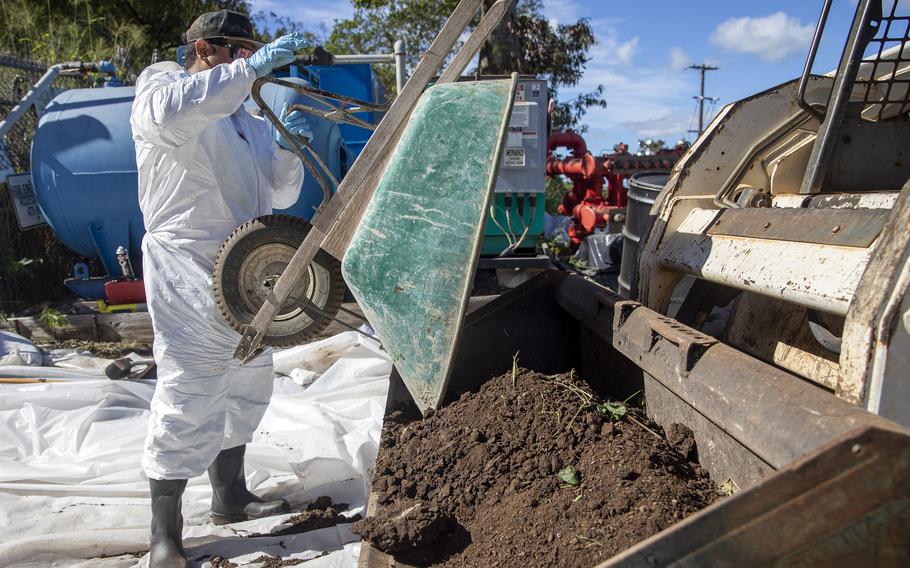
A Navy employee empties a wheelbarrow of contaminated soil onto a tractor on Dec. 1, 2022, during cleanup of a spill of about 1,100 gallons of toxic concentrated firefighting foam at the Red Hill Bulk Fuel Storage Facility in Hawaii. (Matthew Mackintosh/U.S. Army)
The Navy program overseeing cleanup of toxic “forever” chemicals at the Red Hill fuel facility is operating at half its staff after six months of workforce reductions and a hiring freeze by the Trump administration, the program’s manager told Hawaii lawmakers Monday.
“We have taken a significant cut,” Jocelyn Tamashiro, manager of Naval Facilities Engineering Systems Command’s Pacific Environmental Restoration Program, said during a meeting of the House Special Committee on Red Hill in Honolulu.
“In terms of people, we are very short-handed,” Tamashiro said in response to a committee member’s question about whether federal workforce reductions had affected the program.
The program evaluates and cleans up hazardous material spills and former waste disposal sites on military properties in the Pacific region.
In November 2022, about 1,100 gallons of a PFAS-infused firefighting foam concentrate spilled at the Red Hill Bulk Fuel Storage Facility near Joint Base Pearl Harbor-Hickam.
That incident followed a massive jet fuel spill a year earlier at the facility.
PFAS, or perfluoroalkyl and polyfluoroalkyl, is a class of hazardous chemicals that have been commonly used in manufacturing and fire suppressants since the 1950s.
Exposure to some types of PFAS may lead to a variety of health effects, including an increased risk of cancer, according to the U.S. Environmental Protection Agency.
“I had nine staff prior to the new administration,” Tamashiro said. “Two took the deferred resignation, so that left me with seven. I’m supposed to have 15 total in my staff. I’m pretty close to 50% with vacancies.”
President Donald Trump’s administration in February moved to reduce the federal workforce by offering deferred resignations to wide swathes of federal workers, under which employees would no longer work but be paid until Sept. 30.
Meanwhile, many civilian positions in the Defense Department remain vacant due to a hiring freeze.
Tamashiro said her program was dealing with the staff shortage by “prioritizing” cases that pose the most immediate threat to human health and the environment.
“You know, unfortunately, with prioritizing our work, we’ve had to maybe put a little bit of the sites that are not over a drinking water aquifer and not close to any drinking water resources, a little bit towards the bottom of the list,” she said.
She said the program had not seen any interruptions in “communications” with the EPA regarding the Red Hill case. The EPA has also undergone deep workforce cuts.
The Navy has identified 20 sites on and near Pearl Harbor-Hickam suspected of contamination by PFAS, according to an April 2024 report by the Government Accountability Office. Cleanup could take decades.
The Defense Department has directed that the investigation and cleanup of those sites — including the 2022 Red Hill spill — to advance under the Comprehensive Environmental Response, Compensation and Liability Act of 1980, more commonly referred to as the EPA’s “Superfund,” the GAO said.